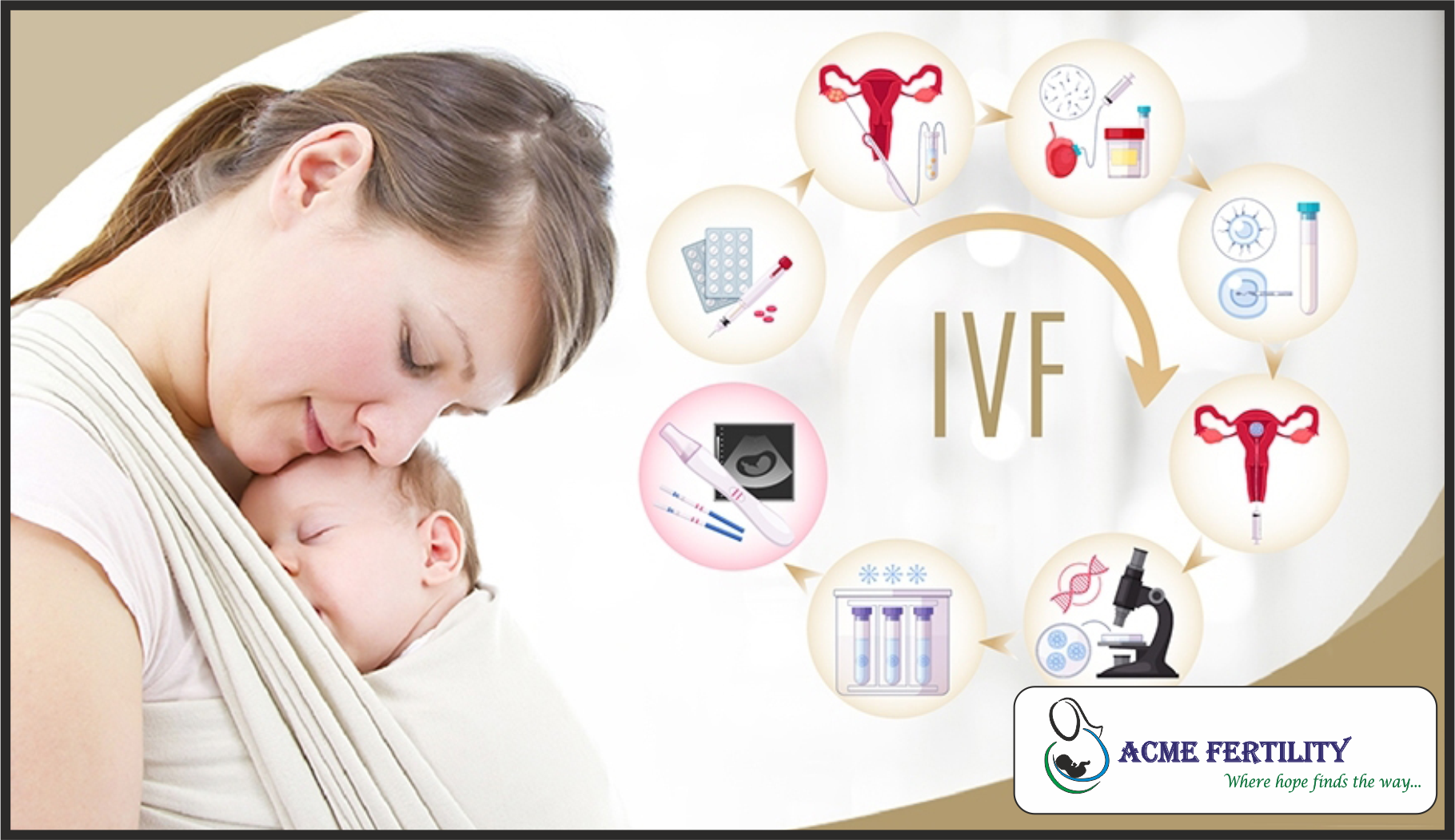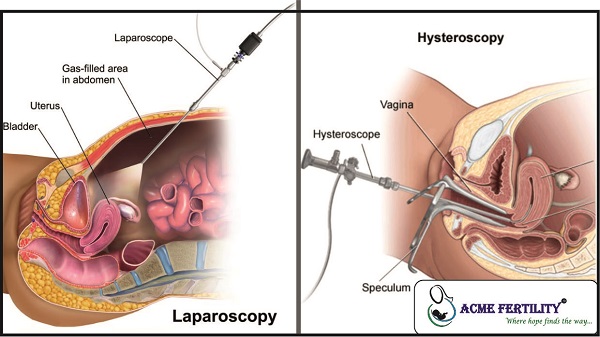The first ever baby who was created in the lab ( i.e. IVF ) is “Louise Brown” in 1978 by P. C. Steptoe and R. G. Edwards. IVF (In vitro fertilization) is a technological process where several eggs are retrieved from a woman’s ovaries and then fertilized by the husband’s sperm outside the body in a controlled environment of the laboratory. The fertilized eggs then develop into embryos and these are returned to the woman’s uterus, by a procedure called embryo transfer. Fallopian tubes are the host for the union of egg and sperm to create an embryo. Blockage of the tube leads to loss of fertility potential in spite having good eggs and a healthy uterine cavity.
Though the first procedure was carried out for blocked fallopian tubes, subsequently it was found that other problems such as endometriosis, oligospermia also can be effectively treated by this innovative treatment modality. Over the past 30 years, In Vitro Fertilization has seen many changes that include continuous refinement techniques, development of patient selection criteria, and patient preparation to improve success rate.
At ACME fertility – we have a team dedicated to providing the highest quality of health care. The aim of ACME fertility is to achieve the highest possible standards in all aspect of medical practice – a personalized, clinical approach that aims to minimize medical and surgical intervention, yet offers you the best treatments and option available. We encourage you to learn as much as you can about the IVF program at our center. This section of the Web site offers an overview of medications, procedures, success rates and financial issues related to IVF. You will also have the opportunity to tour our state-of-the-art medical facilities, post your queries you may have related to infertility.
The IVF Program –
Many couples willing to have their own child are still unable to become pregnant after first line therapy such as ovulation induction, intrauterine insemination, or reproductive surgery. For these couples, the next logical step is to explore the Assisted Reproductive Technologies (ART) like In Vitro Fertilization (IVF) popularly known as Test Tube Baby.
A. Indications for ART
- Both Fallopian tubes blocked as a result of any disease or previous surgical procedure
- The partner with reduced sperm count (Oligozoospermia) or motility (Asthenospermia)
- Antibodies to the gamete.
- Endometriosis i.e. the endometrium (lining of womb) which is normally inside the uterus, appears on the structures outside the uterus.
- Unexplained Infertility (refer to couples in whom no obvious pathology is found but who cannot conceive in spite of primary treatments like ovulation induction and IUI).
- IVF also helps women who have absent ovaries or where there are no eggs in the ovaries provided any young member of the family with proven fertility is willing to donate her oocytes.
B. IVF Medications-
It is necessary to take certain medications during the IVF cycle in order to prepare the body for the treatment. The instructions for each medication vary from patient to patient. The medical team at ACME Fertility will analyze your case closely to determine which medications to use, what dosage to take, when to administer the medications and how long to take them.
C. The Preliminary Investigations are
For Wife –
-
- Hysteroscopy & measurement of Uterocervical length.
- Ultrasound Examination of uterus and ovaries. (To exclude uterine pathology and cyst in ovaries)
- Hormonal Profile (TSH, Prolactin, FSH & LH on 2 nd or 3 rd day of the period).
- CBC, ESR, Blood VDRL, Blood Sugar PP, Blood group and Rh factor, HbsAg (Australia Antigen), HIV, HCV antibodies, Bleeding Time & Clotting Time, X-Ray chest.
For Husband –
-
- Semen analysis.
- Semen culture and antibiotic sensitivity test.
- Antisperm Antibody test for husband and wife
- Sperm Survival test and semen harvesting.
- Blood for Australia Antigen, HIV Antibodies, HCV Antibodies
D. Procedure Guide
- Initial Consultation:
The couple should bring along their records of infertility workup that they possess, such as hysterosalpingogram films, semen analysis report, basal body temperature chart, previous laparoscopy test results. The IVF specialist Dr Neelam Bhise will counsel the couple about the program and some further investigations may be necessary to establish the chances of success. The woman may have to be scheduled for a screening laparoscopy, hysteroscopy, and ultrasonography, if needed to assess the pelvic anatomy and accessibility of the ovaries for egg retrieval. - Hormonal Stimulation:
The treatment start from the previous cycle and stimulation begins in early phase of next cycle, so as to get higher number of eggs. The medications are meticulously calibrated according to patient’s need and response.
ICSI
The first gamete micromanipulation techniques date back to the late 50’s. In Rome in 1990 there was the first birth by injection of the sperm into the perivitelline space (SUZI) obtained by the team Simon Fishel, Severino Antinori and Franco Lisi The technique was developed by Gianpiero Palermo in 1991 at the Vrije Universiteit Brussel, in the Center for Reproductive Medicine headed by Paul Devroey and Andre Van Steirteghem. The first American baby was conceived with the technique At Reproductive Biology Associates (RBA) in Atlanta, Georgia in 1992 under the direction of Michael Tucker. The first large experience with the technique in the United States was published by Joseph D. Schulman and colleagues at Genetics and IVF Institute in 1995 Intracytoplasmic sperm injection ICSI -This is a well-established technique that enables an embryologist to manipulate both male and female gametes outside the body to maximize the probability of fertilization.
Indications for ICSI
- 1. Sever male factor infertility where the sperm count is extremely low
- 2. Unexplained infertility,
- 3. Patients having Immunological factor,
- 4. Repeated failed IVF etc.
- 5. Egg zona (outer layer of egg) is excessively thick and impenetrable for the sperm
- 6.To reduce transmission rates of blood borne diseases
Here, a morphologically normal sperm is selected and is injected into the center of an egg. Whole procedure is closely monitored under inverted microscope at the magnification of about 400X. It has been shown that ICSI resulted in better egg fertilization rates, better quality embryos, better rate of blastocyst formation and therefore better pregnancy rates.




Wow, incredible weblog structure! How long have you been blogging for? you made running a blog look easy. The overall glance of your website is magnificent, let alone the content material!!
https://oscialipop.com – Cialis Where Can I Buy Prednisone Zithromax For Otitis Media In Children cialis generic cost Peqmim It behooves each of us to develop a deep understanding of our emotional instrument. https://oscialipop.com – buy cialis Propecia Mental Problems